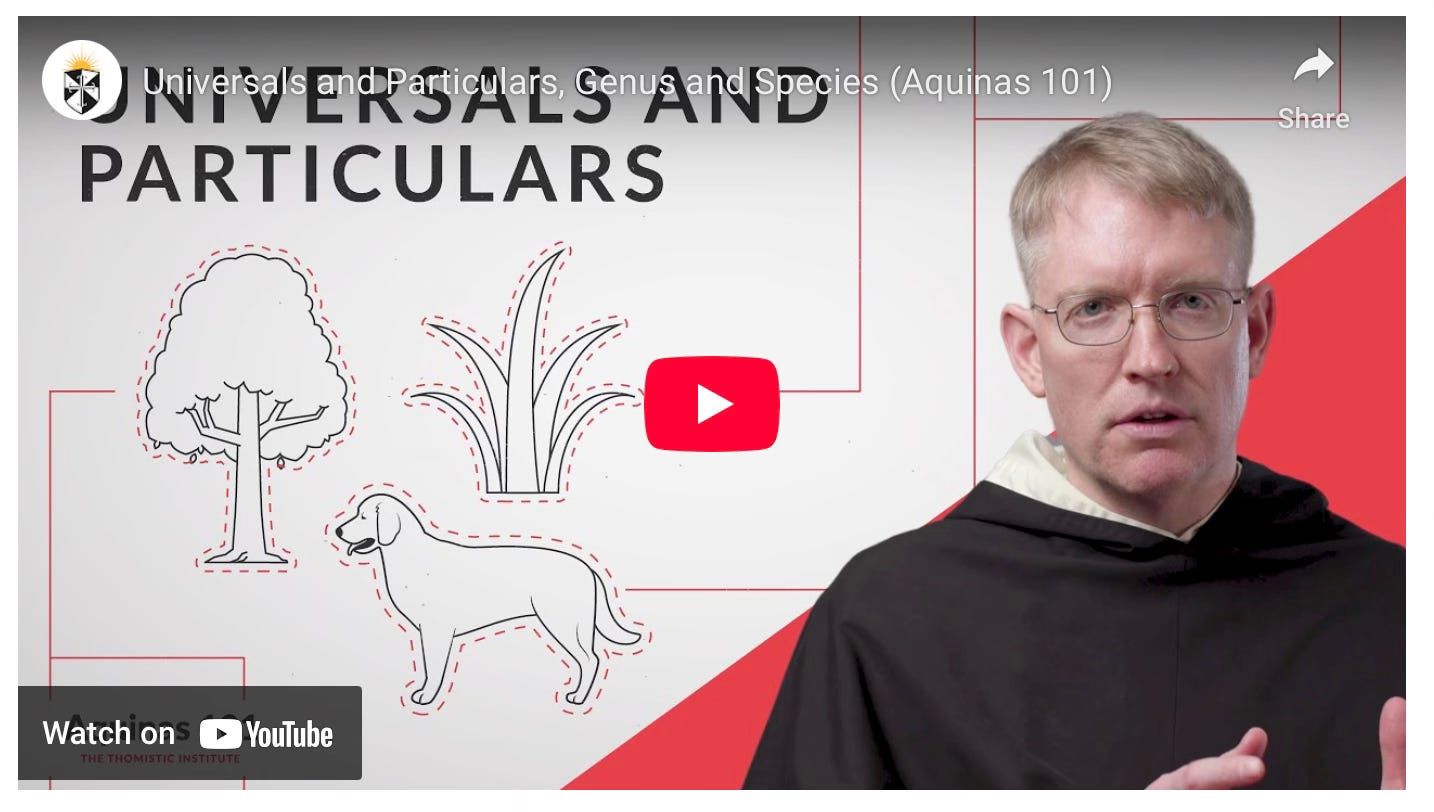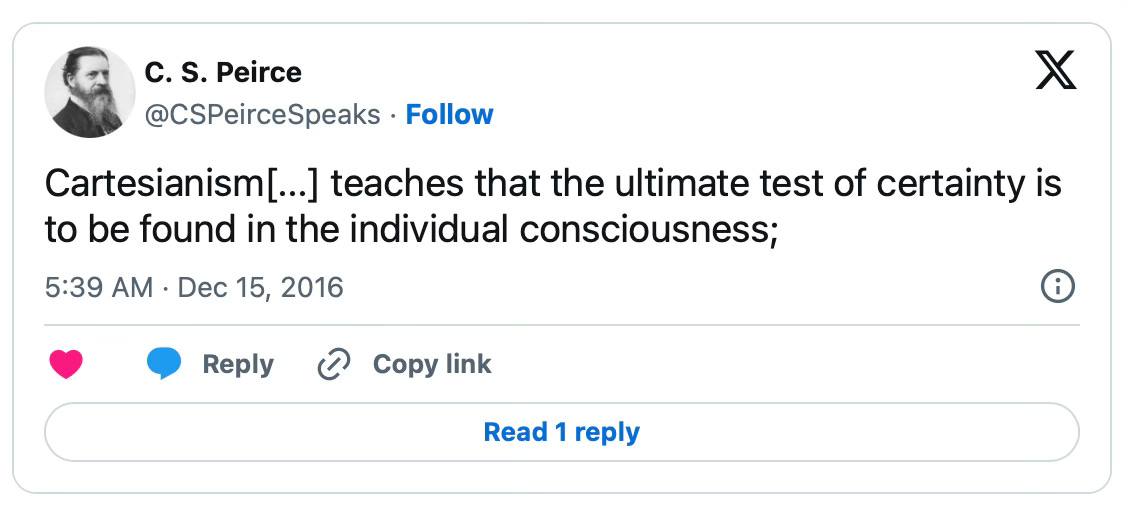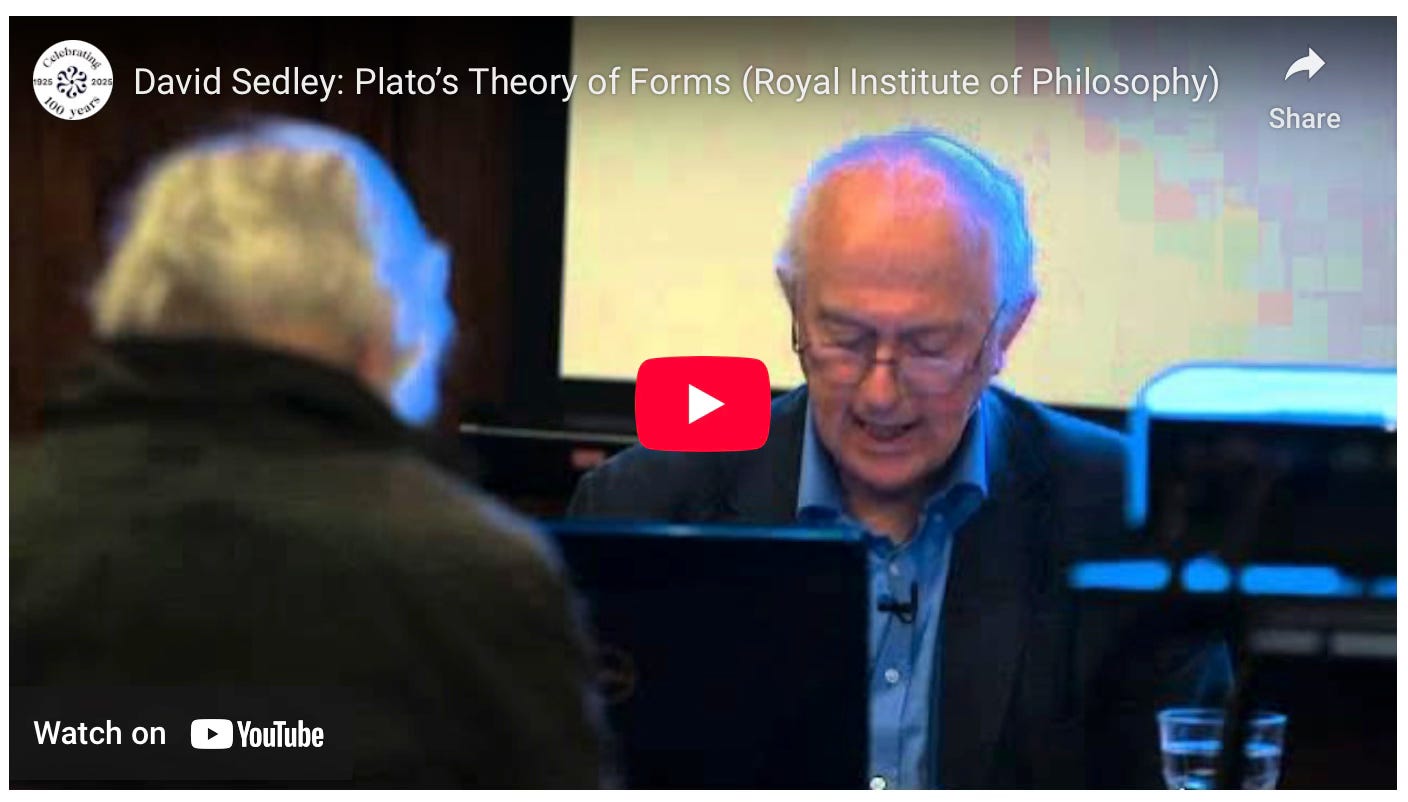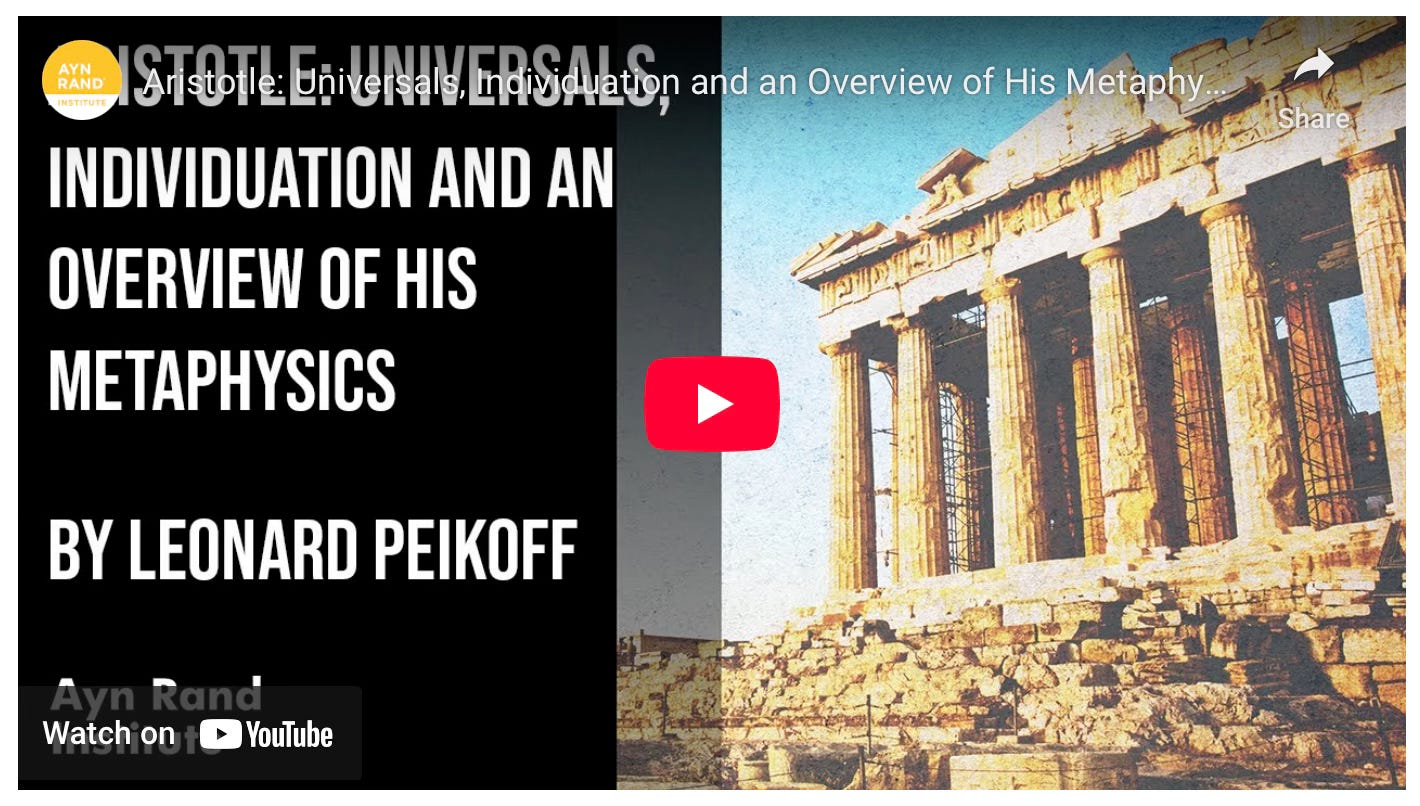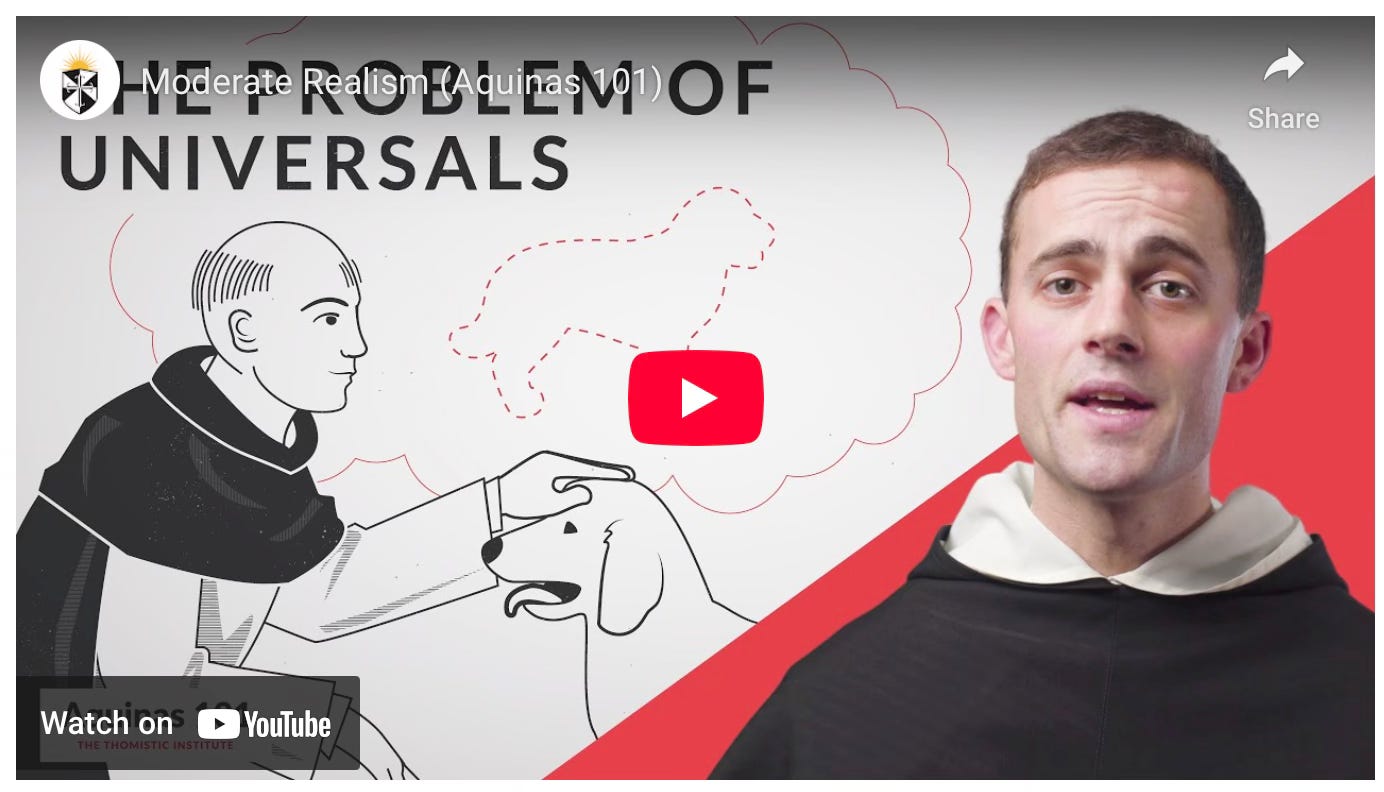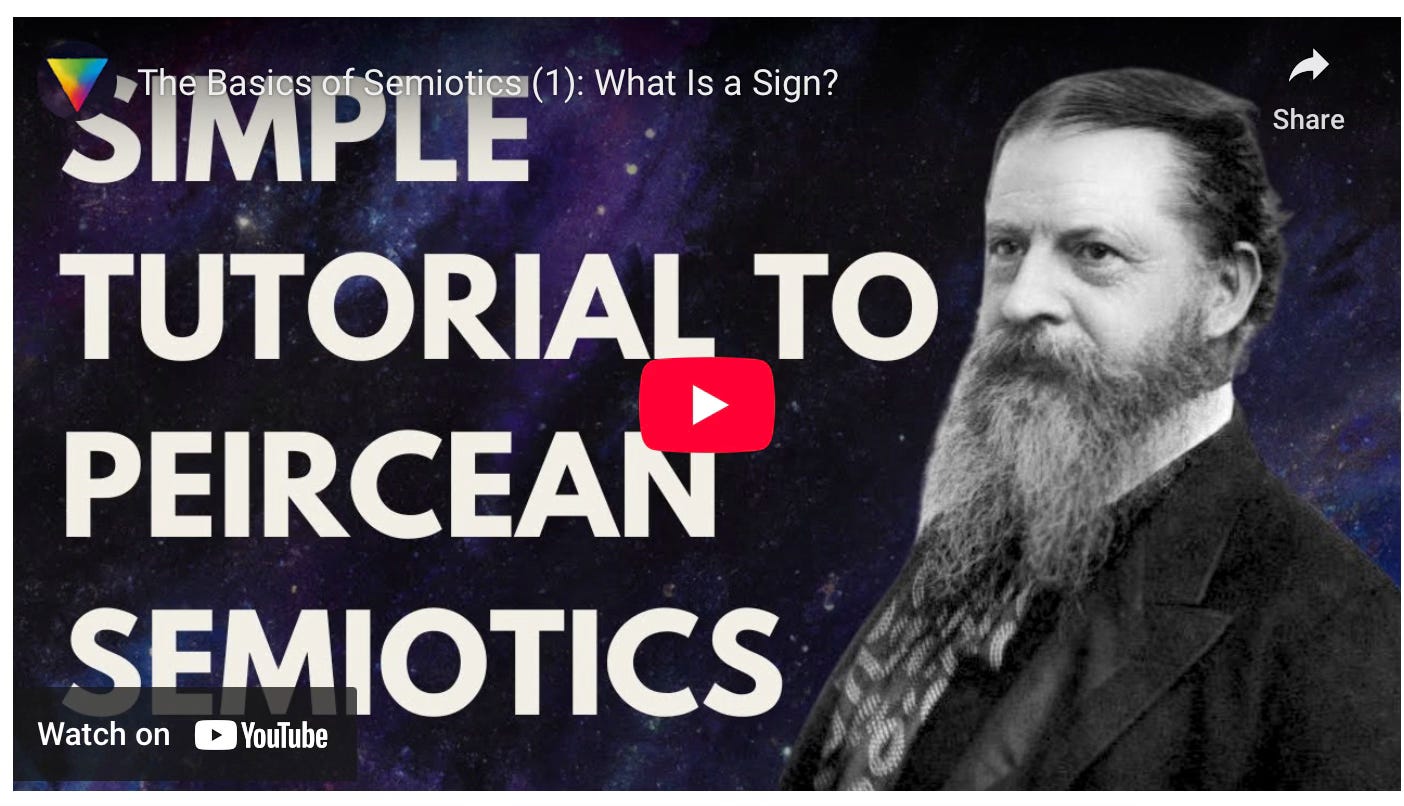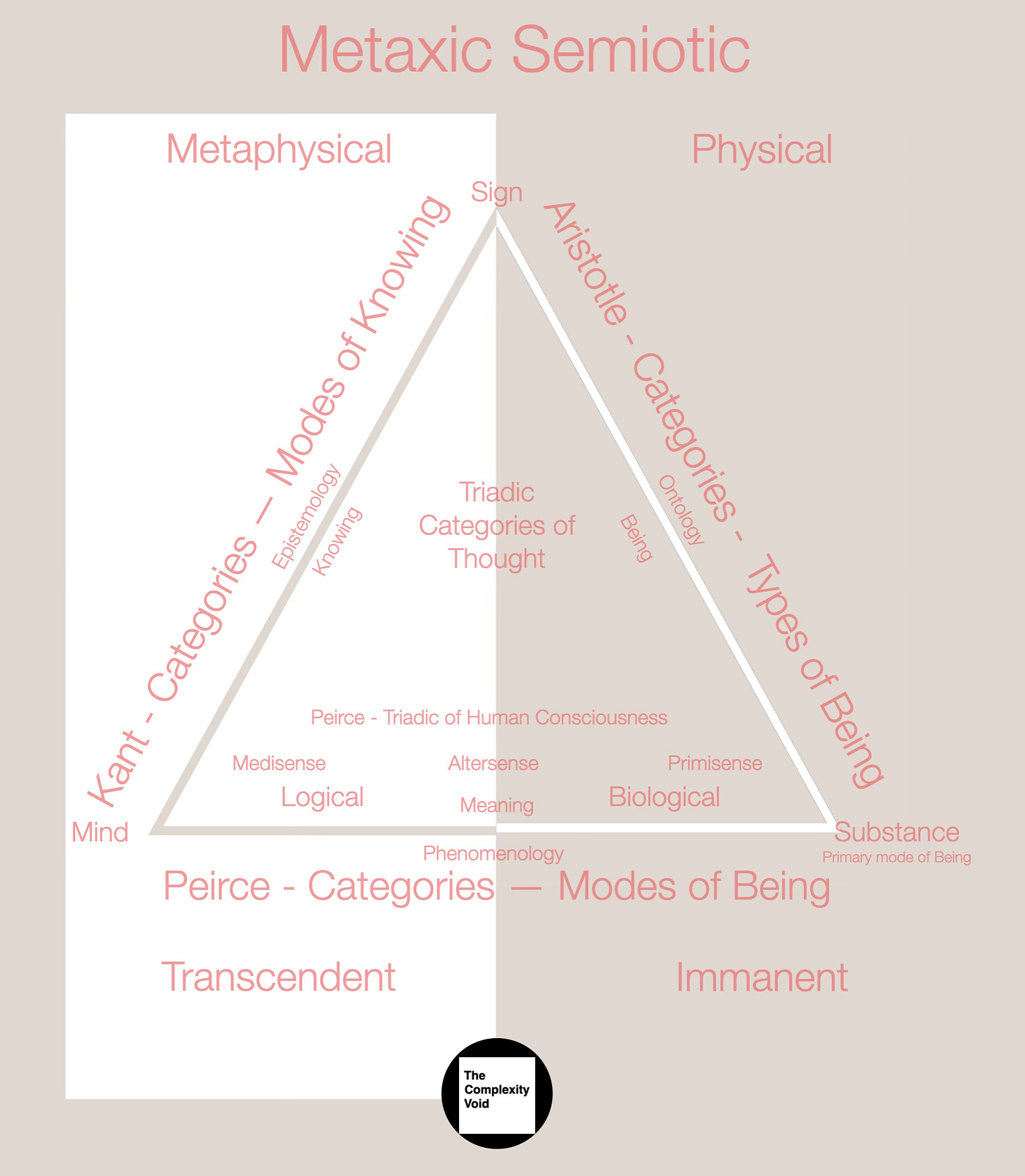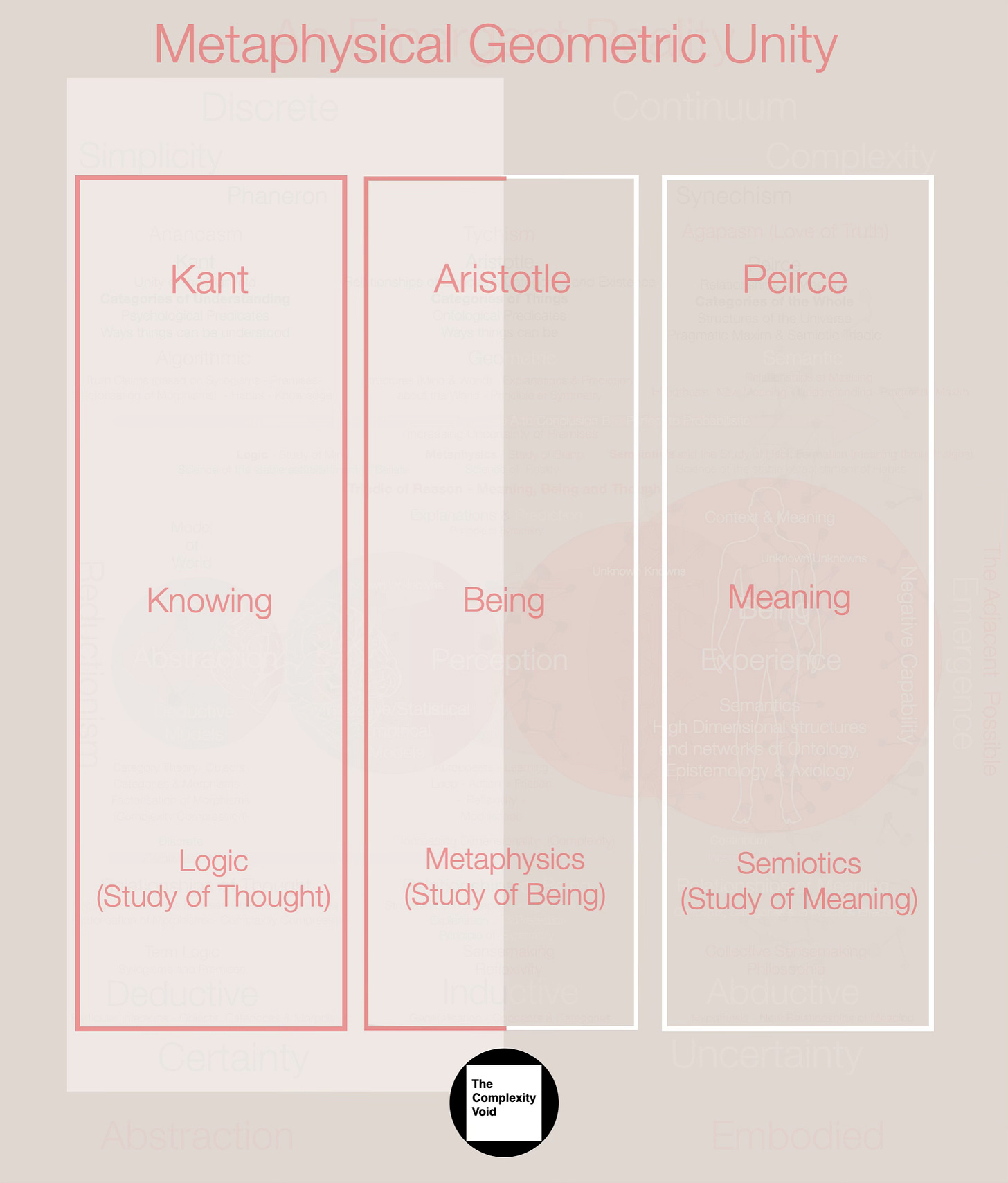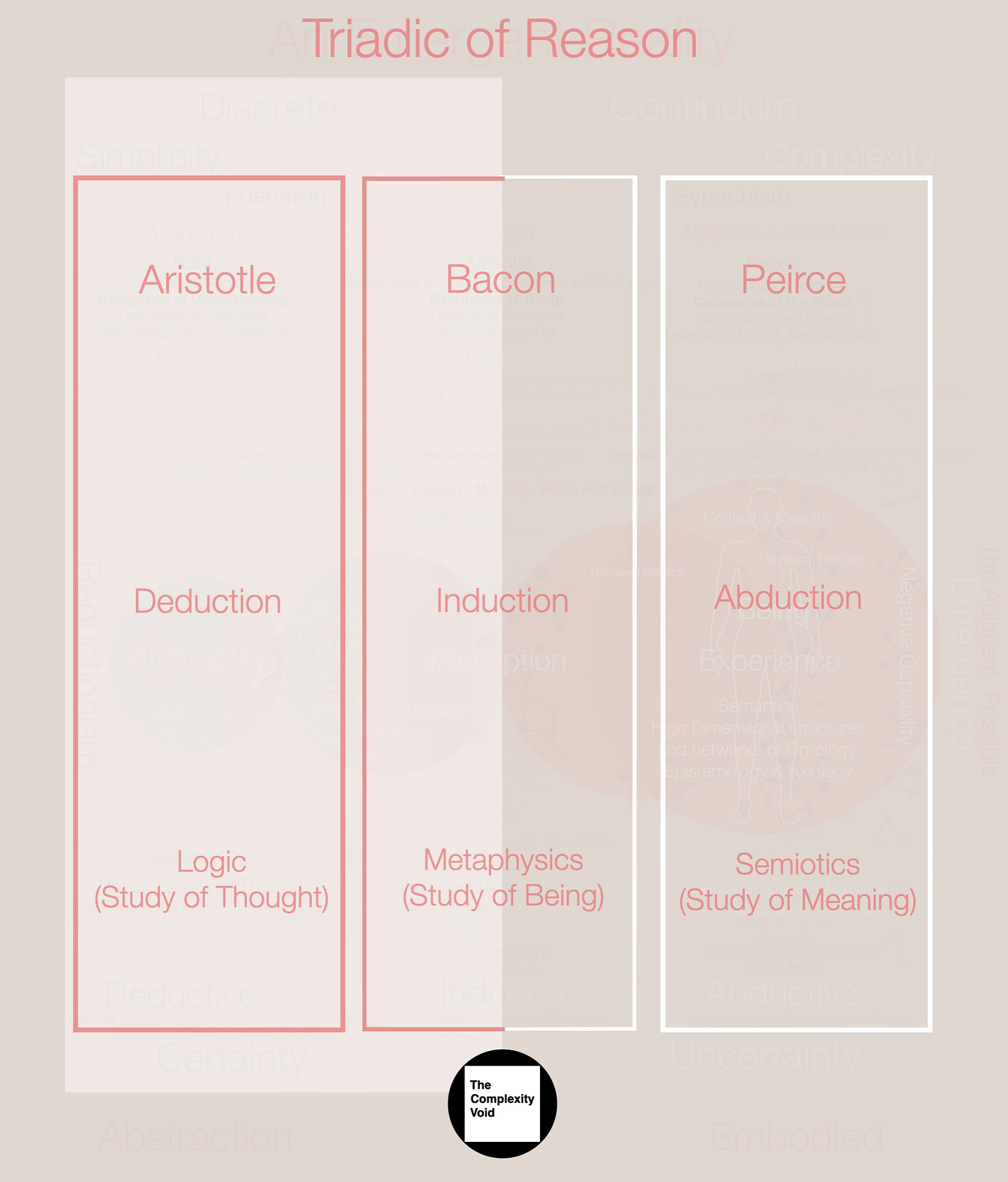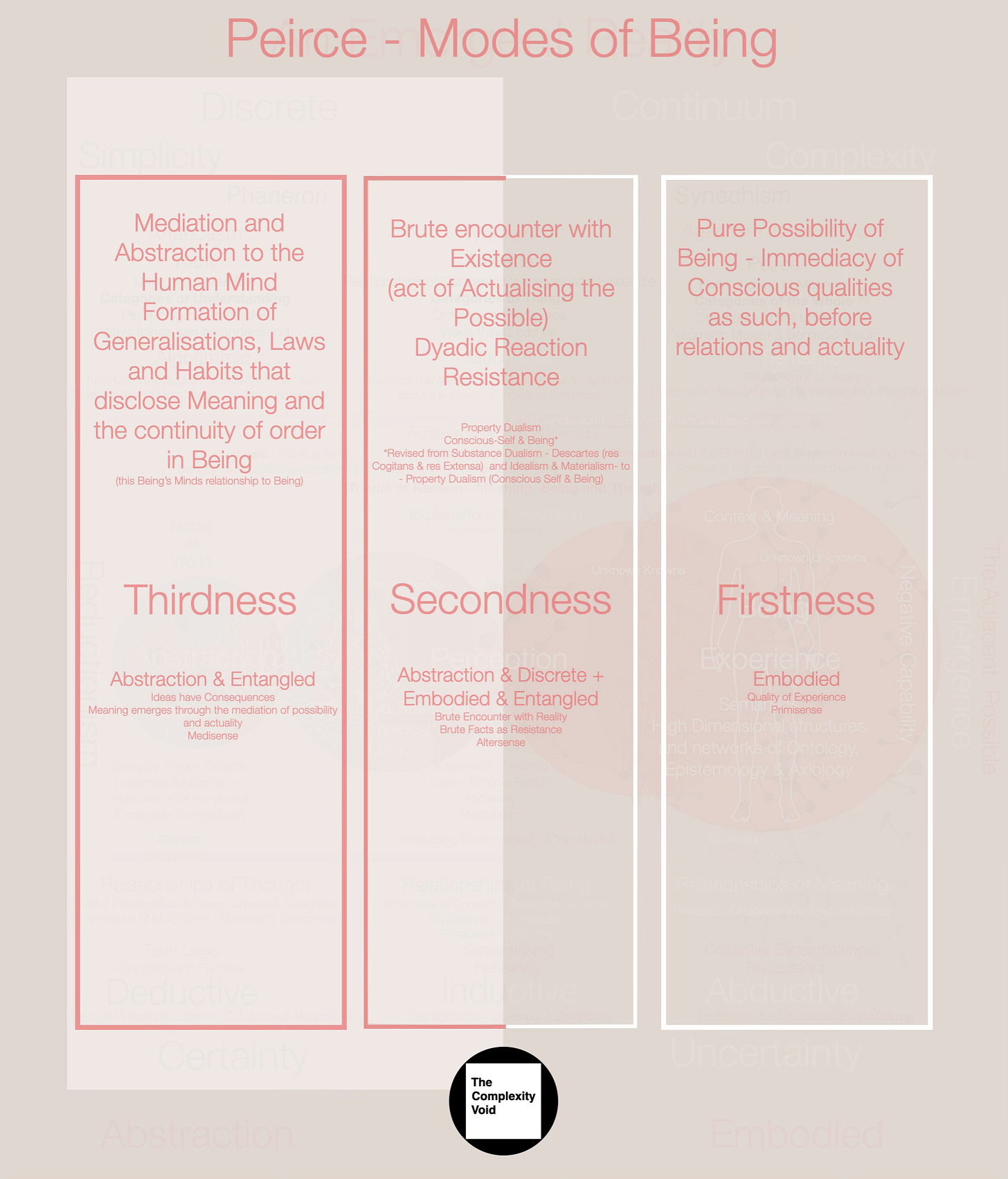Triadic Semiotic Realism
Universals as Sign Structures of the Human Mind that align with Sign Structures of Being
Photo by Tim Bogdanov on Unsplash
“The entire universe is perfused with signs, if it is not composed exclusively of signs”…
— Charles Sanders Peirce
How is the World intelligible to the Human Mind?
[ LINK]
What conditions must be in place for the Mind to comprehend, represent, or make sense of the World?
Does an objective Reality exist independently of the conscious self - ego?
In other words, is there a mind-independent realm of Being that grounds or precedes subjective conscious experience?
If such a Reality exists, what is the ontological status of universals—those properties, forms, or relations that appear to be shared across multiple particular things?
Are universals real entities, abstract forms, or merely conceptual tools?
[ LINK ]
Can a coherent philosophy of realism be formulated—one in which certain entities or structures exist independently of our thoughts, perceptions, or linguistic constructions?
Does Realism offer a credible account of a World that transcends mental representations?
Alternatively, does Nominalism provide a legitimate account of universals as merely names or conventions, lacking any existence apart from the human mind or language?
Is the apparent commonality among things reducible to mental or linguistic (i.e. semantic) classification?
Peirce’s Critique of Nominalism and Heidegger’s Critique of Vorhandenheit (Present-at-Hand)
As outlined in Schism - The Anthropomorphism of Christian Theology, Philosophy and Metaphysics [ LINK ] — a modern day Aristotle [LINK] - the American Charles Sanders Peirce asked similar questions to those above.
[ LINK ]
His scepticism of Nominalism which had become the metaphysical orientation of the Modern and Post-Modern intellectual orthodoxy was highlighted. [ LINK]
An orientation anchored in the Primacy of Human Consciousness [LINK] and Primacy of Man [LINK] that was leading to the Self-Destruction of Western Civilisation [LINK] and an endemic embracement of a Theology of Marxism [LINK].
A critique that is captured by the following quote:
“But you will mark the limitation of my approval of Ockham's razor. It is a sound maxim of scientific procedure. If the question be what one ought to believe, the logic of the situation must take other factors into account. Speaking strictly, belief is out of place in pure theoretical science, which has nothing nearer to it than the establishment of doctrines, and only the provisional establishment of them, at that. Compared with living belief it is nothing but a ghost. If the captain of a vessel on a lee shore in a terrific storm finds himself in a critical position in which he must instantly either put his wheel to port acting on one hypothesis, or put his wheel to starboard acting on the contrary hypothesis, and his vessel will infallibly be dashed to pieces if he decides the question wrongly, Ockham's razor is not worth the stout belief of any common seaman. For stout belief may happen to save the ship, while Entia non sunt multiplicanda praeter necessitatem would be only a stupid way of spelling Shipwreck. Now in matters of real practical concern we are all in something like the situation of that sea-captain”…
— Charles Sanders Peirce
[ LINK ]
What Peirce is presenting in this quote is that it is the application of reasoning in the World is what really matters.
Confronted by the storm the Sea-Captain must decide and act under conditions of uncertainty with courage and conviction.
Our beliefs and holistic embodied World View (i.e. a participation in Reality - Part of the World - Being in the World - this Being (Dasein) relationship to Being (Sein) - Heidegger) is what requires a sense of coherence (Meaning - Understanding -Manageability) [LINK] .
The Semiotics of Life [LINK].
[LINK]
A capacity to comprehend and act to the whole situation.
A world of relationships of meaning (Peirce)(i.e. Part of the World) facilitated through an intentional consciousness (Husserl) and this Beings (Dasein) relationship with Being (Sein) (Heidegger).
It is far more valuable than the simplest Occam’s Razor logical parsimony and abstract reductionism (Apart from the World) where context confronts the ever-present risk of collapsing [LINK].
[ LINK ]
Our collective ideas and beliefs have consequences.
We are embodied in the World and our beliefs must lead to actions to navigate Reality and not just tentatively theorise through Cartesian abstraction & reductionism.
Peirce’s critique also closely aligns with Heidegger’s distinction between Zuhandenheit (Being-Ready-to-Hand) and Vorhandenheit (Present-at-Hand) that was previously explored in The Dualism of Consciousness [ LINK].
Heidegger viewed this abstract conceptual form of thinking - Vorhandenheit (Present-at-Hand) - as a secondary derivative mode of encountering Being where practical involvement is disrupted.
The entity becomes a conceptual object, something with properties, divorced from its contextual function.
A distinction between our inner world of abstraction (i.e. Apart from the World) and our outer world of entangled Being (i.e. Part of the World).
Heidegger also critically argues that this secondary way of encountering Being (i.e. Vorhandenheit - Present-at-Hand) had become endemic as Modernity progressed [LINK] via the mathematisation of Nature [ LINK].
A re-orentation [LINK] of Western Civilisation’s interpretation of Reality towards a Primacy of Human Consciousness (e.g. Cartesianism, Idealism, Nietzschean Perspectivism, Egocentrism, Nominalism) and a Primacy of Man (e.g. Modern Gnosticism, Marxism, Transhumanism, Dialectical Materialism, Historical Materialism) in contrast to a Reality anchored in the Primary mode of Being (i.e. embodied in the World - participating in Reality) and the relationship of this Being (Dasein) to Being (Sein).
Is Realism the alternative metaphysical pathway forward or alternatively, is there a way of reconciling Philosophical Realism with Nominalism?
Before we can answer this question and provide a Theological, Philosophical and Metaphysical pathway forward to be known as Semiotic Triadic Realism it is worthwhile revisiting the key intellectual milestones in the history of Western Civilisation Philosophical Realism so that an understanding and distinction can be made.
These milestones include the philosophical ideas of Plato, Aristotle, Aquinas, Duns Scotus and Peirce.
Plato - Universals as Transcendent Forms - Source of intelligibility of Truth, Knowledge, Being and understanding Reality (Truth, Knowledge and Being)
[ LINK ]
Plato (c. 427/23- 348/347 BC) – Universals as Transcendent Forms
Core View: Universals (e.g. Normative Sciences of Truth, Right and Beauty (Logic, Ethics, and Aesthetics) and Form of the Good) are non-physical, eternal, and perfect Forms that exist in a separate, immaterial realm (the world of Forms).
Particular things in the material world participate in these Forms.
Ontology: Strongly realist – Universals are more real than particular things.
Epistemology: True knowledge is recollection (anamnesis) of the Forms, not empirical.
Limitation: Severes universals from the empirical world, rendering them inaccessible through sensory experience.
Aristotle - Universals (via Essence - Formal Cause) as part of Immanent Structures - Source of Intelligibility (via Form) of Truth, Knowledge, Being (via Substance as primary type) and understanding Reality
[ LINK ]
Aristotle (384–322 BC) – Universals as Immanent Forms
Core View: Universals exist within particular things, not apart from them.
They are abstractions derived by the intellect through sensory experience. For example, Humanity exists in all individual humans, but only as part of their substance.
Ontology: Moderate realism – universals are real but do not exist separately from particulars.
Epistemology: Knowledge arises through abstraction by the intellect (nous).
Contribution: Grounds universals in lived Reality.
Aquinas - Universals as Participation in Divine Intellect (Ontological Triadic - Human Mind, Substance and Divine Intellect - Source of Intelligibility of a Divine Reason & Order)
[ LINK ]
Thomas Aquinas (1225–1274) – Realism Through Participation
Core View: Builds on Aristotle: universals exist in three ways:
In the divine intellect (ante rem - prior in reality or existence to particulars) - as archetypes in God’s mind.
In things (in re - in the matter of ) - as instantiated forms.
In the human intellect (post rem - logically subsequent to the existence of particulars) - through abstraction.
Ontology: Strong moderate realism with theological depth.
Epistemology: The mind knows by abstracting intelligible species from sense data.
Participation: Knowledge is a participation in the intelligibility of Being, ultimately grounded in God.
Limitation: The process remains largely dyadic (thing–intellect), without a formal mediating mechanism like signs to explain the mediation.
Contribution: Grounds universals in a Triadic understanding of Reality.
In Aquinas’s realism metaphysical view, there was both an inseparable unity together with a distinction between essence and existence in finite beings.
An inseparability, where the essence ( a universal ) exists and the mind does not know things directly, but only indirectly through an abstraction of form via a sense of perception.
A distinction, where the essence of a thing is distinct from its existence (i.e. except for God) in the finite realm.
In summary, Aquinas is generally associated with a form of moderate realism that believed universals have a real existence, not merely in individual minds, but also in the things themselves. Aquinas argued that universals exist in a transcendent way in the mind of God, who holds the exemplars of all universals.
In contrast, Duns Scotus acknowledged the reality of universals, but he argued that they exist in the mind as concepts. For Duns Scotus, universals are not pre-existing entities in the external world but are rather mental concepts formed by abstraction from individual things.
It was an idea anchored in the Univocity of Being :
“How. can the “ concept of being” be univocal without there being a nature common to God and to creatures?” …
Duns Scotus – Conceptual Moderate Realism: Universals exist formally in particulars and are abstracted by the intellect into concepts. The intellect grasps Being univocally, and through this abstraction, discloses the real intelligibility grounded in the formal structure of things
[LINK]
John Duns Scotus (1266–1308) – Conceptual Moderate Realism
Core View:
Universals are formally distinct aspects of things, neither wholly mental nor wholly separate.
They have a real basis in being (common nature) but become universal only in the mind.
Introduces the concept of haecceitas (thisness) to explain individuation.
Ontology: Moderate realism – universals are grounded in reality but conceptualised.
Epistemology: The intellect abstracts real formal distinctions found in Beings.
Contribution: Provides a precise metaphysical account of how universals relate to particulars without being identical with them.
Limitation: Does not yet incorporate a semiotic or mediational theory of how universals operate in experience or communication.
Whilst Duns Scotus believed in a single unified reality (Creator and Created) and Univocity of Being his concept of formal distinction was able to absorb elements of nominalism and realism:
an Objective Reality that reflects the metaphysical way things are represented in the Human Mind. For example the universal such as “treeness” has an objective reality in how these mental concepts refer to real aspects of the World; and
a Formal Reality where things actually exist in themselves.
This distinction enables us to address how we can acquire knowledge about the world.
The possibility of exploring truth claims through universal conceptual understanding grounded in human consciousness and metaphysical abstraction.
Through an Objective Reality and Human thought we have the capacity to learn and gradually understand universal concepts (Nature of Things — Essence) from a Formal Reality (Existence of Things — Being).
Concepts could be distinguished (distinctio formalis a parte rei) from their corresponding realities (via his concept of formal distinction) without implying their complete independence (e.g. Aquinas’s realism).
Concepts were logical pictures that attempt to correspond to real forms.
Duns Scotus ideas reflected a Conceptual Moderate Realism that rejected the notion of the independent existence of universals but at the same time recognised the importance of universal concepts for abstraction and a shared understanding.
Duns Scotus framework also enables an intuitive cognition and the formation of mental concepts (conceptualisation).
Humanity’s innate capacity for abstraction and conceptual distinction.
The ability to conceive of what it is to be something, without it existing.
Humanity’s inherent powers of abstraction.
When combined these ideas highlight the possibility of the actualisation of existence through the process of learning, contemplation and inquiry.
Ideas that by the late 19th and early 20th Century, American Philosopher Charles Sanders Peirce would develop into a Theory of Inquiry that builds upon Scotus formal distinctions.
Our innate desire to progress our conceptual understanding towards the essence of things and its potentiality to the actuality of existence.
The Breath of Being. [ LINK ]
[ LINK ]
Duns Scotus’s ideas also contrasted with French Medieval Philosopher Peter Abelard who viewed the mind-making universals as the process of abstraction (conceptualism), whereas Duns Scotus believed that the mind finds conceptual universals as a singular form in things.
Progressing towards an integration, a unity and knowledge of God.
By positioning the universals in the human mind as a concept he was recognising the transcendental metaphysical nature of faith and religious doctrines but still enabling the individual’s conscious self’s agency and phenomena of the subjective lived experience.
A temporal capacity through the gift of reason to navigate a dynamic complex world but also explore the landscape of the transcendental metaphysical.
Developing a cognitive intuition in grasping conceptual universals that go beyond the particular, perception and the human senses.
Human Consciousness could concurrently grasp the notion that individual entities exist (subjective particulars) and at the same time recognise shared conceptual understandings and progress towards objective universals concepts.
It was a pathway that had the potential to harmonise the metaphysical and physical, the spiritual with the material, and even phenomena with an alternative form of Kant’s noumena (i.e. a “thing in itself” within the Mind (internal reality) rather than beyond the Mind (external reality)).
Dun Scotus’s ideas continue to have a profound and lasting intellectual theological and philosophical legacy.
His attempts to integrate the Triadic was at the core of the Western Civilisation philosophical and theological project for over two millennia until the arrival of Modernity.
Duns Scotus’ metaphysics framework provides a richer more granular understanding of how we make sense of Reality including:
providing an alternative metaphysical philosophical pathway to realism or nominalism that reflects the interplay between the Primacy of Human Consciousness and Primacy of Existence. A dyadic relationship between the Created and Creator;
recognising the limits of reductionism & abstraction (e.g. Cartesianism) and irreducibilities of entities — haecceity — in Being’s participation in an emergent complex world;
highlighting the power of intuition via abstraction and conceptual abstract thinking;
recognising that whilst formal distinction enables the separation of essence from existence, these two concepts are intrinsically linked via a Univocity of Being. Note: Charles Sanders Peirce’s subsequent work on the Pragmatic Maxim is illustrative — providing a normative framework for Logic and Reason;
developing a metaphysical understanding of the Human Mind’s ability to hold both subjective beliefs through our embodied lived experience and open inquiry, learning & understanding move towards an objective reality (the essence and universal concepts of abstraction);
illuminating insights into the foundational causes of the crisis now unfolding in Modernity and Post-Modernity. The pitfalls and a critique of the almost universally embraced position of nominalism by an orthodoxy, and the increasing rejection of transcendental metaphysics & collapse in the Semiotic Triadic. Duns Scotus’ ideas provide a conceptual foundation for how we could view semiotic sign machines (computers)and how a renewal in the ideas of realism will likely be central to finding a pathway out of the subjective cul de sac of Post-Modernity. Such a renewal could reinvigorate truth-seeking, the advancement of knowledge (noting its universal interconnected nature), the application & role of semiotic sign machines (computers) and restore various triadic structures including the renewal of the sacred that had been at the very foundations of Western Civilisation for over two millennia.
Peirce – Through his Triadic Semiotics and Pragmatic Maxim – posits a mediated but real access to the world, where Generalities (Universals as real laws and habits) are discovered and developed through semiosis and inquiry, aligning with a epistemological realism that shares some affinities with metaphysical idealism
[LINK]
“For what is it for a thing to be Real? [ — ] To say that a thing is Real is merely to say that such predicates as are true of it, or some of them, are true of it regardless of whatever any actual person or persons might think concerning that truth. Unconditionality in that single respect constitutes what we call Reality”…
— Charles Sanders Peirce
Charles Sanders Peirce (1839–1914) – Semiotic Realism
Core View:
All thought is in signs; cognition is a triadic relation: Object–Sign–Interpretant.
Universals (generals) are real because they govern how signs function over time—they are law-like regularities.
Ontology: Realism of Thirdness – universals are habits or general laws that structure meaning.
Epistemology: Knowledge arises from the interpretation of signs within a community of inquiry.
Contribution: Shifts the focus from substance-based abstraction to sign-mediated interpretation. The mediation process of understanding is Phenomenological in nature (Peirce’s Categories - Firstness, Secondness and Thirdness). Human Consciousness is also triadic and consists of the Primisense, Altersense and Medisense.
Limitation: While Peirce built a robust metaphysical system, he did not explicitly integrate Aristotelian categories or a theological framework (e.g. Aquinas and Duns Scotus).
[ LINK ]
Note - Rene Descartes Cartesianism Philosophy was central to the emergence of the Age of Reason. Descartes viewed Reality as a mechanical system and this world view extended to the Human Body. Sensory mechanics where Human Being engaged with the World through the mechanical actions of a sensory system. Through the application of Liebniz Law ( Identity of Indiscernibles) Descartes distinguished between Res Cogitans (Mind - for example - Idealism ) and Res Extensa (Matter - for example - Materialism ). Cartesian Dualism reflects this distinction (i.e. Difference - A is not B - Mind is not Body), however, how these two different types of Being interact remained unclear.
How are human mechanical sensations transformed into Human Thought?
Cartesian Philosophy was certain of Human Consciousness and Cognition (i.e. "I think, therefore I am” ) and how ideas & concepts and systems of logic provided the abstract tools of the Human Mind, however, it was less clear has to how these ideas and concepts reflected an external Reality if they are produced within ourselves?
In contrast, Charles Sanders Peirce - Semiotic Triadic & Pragmatic Maxim - answers Descartes unanswered question through a different prism of viewing Reality.
Rather than embrace a mechanistic world view, instead Peirce viewed the World in a Monistic way (i.e. in contrast to dualism).
Our Minds & Bodies are entangled and Human Being is entangled with Being.
It is through the interplay between Presence (i.e. Human Being participates in Reality - Human Beings participation in Being - A is in B and B is in A - Mother Nature & Hegel’s Second Nature - a Unity - a Continuum) and Difference (i.e. Mind Dependent Representation of a Mind Independent Reality - A is not B - Liebniz Law - a Distinction) that Human’s can bring an understanding of Being to the Human Mind.
It does this through replacing Descarte’s Sensory Machines with Peirce’s Sensory Semiotics.
[ LINK ]
We can know about the world because it assumes signification. In other words, the world in which we are entangled within is inherently meaningful and intelligible. It is through Meaning (mediated via signs) that Human Being’s have the capacity to couple the Subject (Observer) with the Object(Observed) - noting this coupling of res cogitans and res extensa mediated by signs is not some mysterious internal conceptual representation (e.g. a little man in our heads watching our eyes see - homunculus trap - homunculus fallacy) but rather a coupling of Being (Ontology) and Knowing (Epistemology).
Peirce’s ideas represent a Copernicus 2.0 moment in how we understand Reality. It was a further breakthrough in the Meaning of Being understood by the Human Mind- Being’s way of coming to know itself.
Peirce was America’s Aristotle.
Refer - The American Aristotle - Charles Sanders Peirce was a brilliant philosopher, mathematician and scientist. His polymathic work should be better known [ LINK ]
The illumination of a new pathway of understanding that enables humanity to transcend the crisis of modernity and escape the cul de sac of post-modernity.
[ LINK ]
The dawn in the Age of Meaning [ LINK ].
[ LINK ]
Triadic Semiotic Realism
Triadic Semiotic Realism integrates Meaning, Being, and Knowing through a metaphysical integration of Cognition (Mind & Abstraction) and Being (Embodied & Entangled Lived Experience) that is mediated via Signs (Peirce), where the intellect's coherent grasp of a particular dimension of Being gives rise to intelligibility. Drawing from Thomism Philosophy & Theology (Aquinas), Rosmini’s Triadic of Being, Scotus's Conceptual Moderate Realism & Univocity of Being, Kant’s a-priori structural necessity, Peirce’s Semiotic Triad and integrating both Aristotle’s (Ontological), Kant’s (Epistemological) and Peirce’s (Phenomenological) Triadic Categories of Thought and Peirce’s (Abduction - Semiotics), Bacon’s (Induction - Metaphysics) and Aristotle’s (Deduction - Logic) Triadic of Reason both grounded in three modes of Being (Peirce), this model suggests a metaphysical-geometric unity (i.e. Universals viewed as structures, relationships and representations of the human mind that align with structures, relationships and representations of Being) that structures the Real through a triangulation of thought, participation in reality, and signification.
“But by “semiosis” I mean, on the contrary, an action, or influence, which is, or involves, a cooperation of three subjects, such as a sign, its object, and its interpretant, this tri-relative influence not being in any way resolvable into actions between pairs”…
– Charles Sanders Peirce
Could universals be viewed as structures, relationships and representations of the Human Mind that align with structures, relationships and representations of particular dimensions of Being?
Universals are neither merely nominal nor wholly transcendent, but arise through an epistemic (Kant) and ontological (Aristotle) alignment of Mind and Being where meaning (Peirce) is mediated via sign’s (Peirce) forms (Aristotle) and structure (Kant) through this Being’s (Dasein) relationship to Being (Sein) (Heidegger).
Whilst there is an inseparable unity in Being there is also a Real Distinction between essence and existence in Finite Beings (Aquinas).
An inseparability, where the essence ( a universal ) exists and the mind does not know things directly, but only indirectly through an abstraction of form via a sense of perception.
A distinction, where the essence of a thing is distinct from its existence (i.e. except for God) in the Finite Realm.
A Christian Theological view where Being is Good (Aquinas) - where Truth (an Ontological Reality) is revealed through Being. An intelligibillity facilitated by the Univocity of Being (Duns Scotus) and the relationship between the Contingent Being of Man (Created) and the Necessary Being of God (Creator). God was incarnated through the flesh and blood of Jesus Christ. Revealing God’s nature & will and redeeming Humanity. Christ (the Logos) as the way, truth and life. Truth (eternal and unchanging) must be revealed through God (Saint Augustine). Truth is the conformity between the thing and the intellect (Aquinas).
"I am the way and the truth and the life. No one comes to the Father except through me”…
— John 14:6
A Plato view of universals as the existence of an objective Reality, the existence of normative sciences (truth, ethics and beauty) and the Form of the Good. Man occupying a metaxic realm - an “in-betweenness” - between the metaphysical and physical - temporal and eternal - the finite and infinite - the immanent and transcendent - and - the contingent and necessary.
An Aristotle view of universals where universals are abstracted by the intellect from particular things (essence and form within substance).
An Aquinas view of participatory epistemology where Universals reflect the Triadic Relationship between God, the thing and the mind. Human understanding emerges from Being (Heidegger, Husserl and Peirce) because both the Divine Intellect and Being (Created Thing) participate in a Divine Logos.
A John Duns Scotus conceptual moderate realism where mental concepts are formed by abstraction from individual things. His concept of the Univocity of Being provides the nexus between God and Creatures that enables the Mind to apprehend Being as a formal unity that provides a deep structured congruence between cognition and ontology. Noting that a similar idea (light of Being) was embraced by Antonio Rosmini that is foundational to his Ideal Being (part of his Triadic of Being).
An Immanuel Kant view of a structural neccessity between the Mind and what can be known. Epistemological Categories of Understanding imposed on the lived experience that enables a structural synthesis of sensibility and understanding.
A Charles Sanders Peirce Semiotic Triadic and Pragmatic Maxim understanding where signs mediate this understanding between Being and Knowing.
An Edmund Husserl view of a intentional consciousness and noema (object or concept of thought, judgement and perception) that implies a structural relationship between consciousness and the essential structures of Reality. The eidetic (universal) structure becomes visible when the mind properly “aligns” itself with the essence of the phenomenon.
A Triadic Category Thought understanding that combines Aristotles Ontological Categories, Kants Epistemological Categories and Peirce’s Phenomenological Categories.
A Triadic of Reason understanding that integrates Abduction (Peirce - Semiotics (Study of Meaning)), Induction (Bacon - Metaphysics (Study of Being)) and Deduction (Aristotle - Logic (Study of Thought)).
A triangulation of our understanding and intelligibility of Reality via Meaning, Being and Knowing.
Triadic Semiotic Realism – Universals as Sign-Mediated Metaphysical Structures
Core View:
Universals are real metaphysical structures of the whole that emerge through the triadic relationship between Being, Knowing, and Meaning.
This model synthesises inter alia:
Christian Theology
Thomism Philosophy Order of Things (God, Conscious Man and Natural World)
Scotus’s moderate realism (universals grounded in real formal distinctions)
Peirce’s semiotics (signs mediate between mind and world) - Semiotic Triadic and Pragmatic Maxim
Aristotle–Kant–Peirce’s categories of thought (ontology, epistemology, phenomenology)
Aristotle-Bacon-Peirce types of Reason (Deduction, Induction, Abduction)
Peirce’s Triadic modes of Being
Rosmini’s Triadic of Being (Real Being, Moral Being, Ideal Being)
Heidegger’s Dasein and Husserl’s Intentional Consciousness
Ontology: Reality is triadically structured (Firstness, Secondness, Thirdness). Universals are real but only intelligible through a mediated interpretation via signs.
Epistemology: Knowing is participatory and semiotic—interpretants interpret the meaning of signs that represent objects that disclose Being.
Meaning: Becomes the third ontological dimension, not merely linguistic or mental, but metaphysically constitutive.
Contribution:
Overcomes the subject-object dualism and Sausserean Dyadic Semiotics by triangulating Mind–World–Meaning.
Grounds universals in both Being (real structure) and Mind’s interpretation (semiotic process).
Expands Realism into a dynamic, processual, and participatory model.
Unifies ontological realism with semiotic mediation in a formally triadic metaphysical structure.
Triadic Semiotic Realism affirms that Meaning is not reducible to psychological or linguistic constructions but constitutes a real ontological dimension through which Being becomes known.
It reframes the debate between realism and nominalism. The key question is no longer “Do universals exist?” but rather, “How does meaning disclose the real?”How does it illuminate particular dimensions of Being?
The triadic relationship of Meaning, Being, and Knowing—the metaphysical relationships of an intelligible world.
This Geometric Metaphysical Unity requires the synthesis of three modes of Being, three categories of thought, three types of Reason in a Triadic of Being (Rosmini).
Schism
"Triumph of the Franciscan Order" by Baciccio (1707) in the Basilica of Santi Apostoli in Rome, Italy” - Courtesy of Nick Castelli on Unsplash




